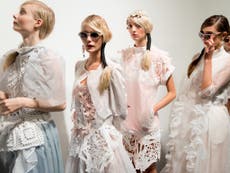By banning skinny catwalk models, we blame women for eating disorders - and ignore the real reasons
As a psychologist, I know that the root cause of negative body image in girls is more to do with how we teach them that their bodies are fragile, breakable and out of their control

On the dawn of London Fashion Week, the issue of skinny models on the catwalk has reared its head again. This time the leader of the All Parliamentary Group on Body Image, Caroline Noakes MP, has called for a ban on underweight models at events, and the creation of enforceable legislation if a voluntary code of conduct isn’t effective. The message seems clear: the extremely thin ideal being presented to young women sets up unrealistic and unhealthy standards of feminine beauty, which leads to skyrocketing rates of eating disorders. But is this really true?
As a psychologist, I know that media images are only a tiny contributing factor to our high rates of disordered eating among young people. However, our sense of ourselves as embodied beings does not just (or even mostly) relate to how we compare ourselves to other, perhaps thinner, women. We don’t only feel good about ourselves because we are skinnier than our friend, or prettier than a famous actress. Girls and women do not rely on being shaped like a catwalk model for their sense of personal validation.
The truth is that our body image is based on a range of factors – factors that include how we are seen by others, but also our sense of what our bodies can and can’t do, how good our bodies feel to us, and how much we feel our bodies define and shape who were are. None of these is simply dependent on how we compare our bodies to other people’s bodies. Our sense of self (of which body image is one component) is built up in more complex webs of social interaction that shape our sense of who we are, what is important about us, how we see ourselves.
We feel generally better about ourselves when we feel that we have some control over the things that happen to us. A girl who feels that she has a say in what happens in her day-to-day life is more likely to feel in control. When she feels she has a voice, that her voice matters, and that she can influence what happens to her by making their voice heard, a girl is more likely to feel capable and valued. A major influencer in body image difficulties – and eating disorders – is a person feeling that they don’t have control over outside factors, meaning that attacking sexism in society could actually be much more important in preventing mental illness than banning skinny catwalk models.
Our capacity to assert ourselves in the world is intrinsically linked to our sense that we can act, that our actions will have an effect. Our sense of confidence in our embodied ability to act is far more strongly shaped by broader social messages about women’s and girls’ bodies than it is to viewing thin models. When we enable our girl children to participate actively in sport, when we let them climb and get grubby, when we let them play rough, we are communicating to them that we have faith in their bodies. This tells girls that we trust their bodies to do, to act.
The girl who feels in control of her world is more likely to feel able to act upon it. When we enable girls to bounce about, when we let them use their bodies to their full capacity, we let girls know that their bodies are not fragile or breakable – they are robust, capable, they are doers, agents of their own lives. Building body confidence in girls is far more about offering them opportunities to experience their bodies positively, and not so much about the images of femininity available to them. Media role models are great. But lived experience of the body’s capacities is better.
As long as our culture is characterised by broader patterns of disparaging and dismissing the feminine, and especially the feminine body, simply banning catwalk models is unlikely to produce a major effect. As long as women’s value is mostly related to their bodies and physical appearance, as long as women’s bodies feel unsafe (for example, because of the pervasive threat of violence many women and girls perceive) these challenges with body image will persist for girls. The constant sense of observation, potential threat, judgement and regulation produces greater body hesitancy. This hesitancy is produced in the insecure conditions of femininity itself. We need a society in which women feel more broadly empowered, safe and respected, if we are to really support young women in feeling more comfortable in their own skin.
In some senses, then, the focus on very thin models seems a wrong turn. Indeed, by focusing just on catwalk models, and by posing ultra-thin women as ‘the issue’, we locate the problem of body image for women in other women. Women feel bad about themselves because other women make them feel bad. This argument reinforces rather than challenges a sense of women being in competition, comparing ourselves to each other, being bad for each other. But when it comes to body image, I don’t believe that women are the problem. Do you?



Join our commenting forum
Join thought-provoking conversations, follow other Independent readers and see their replies